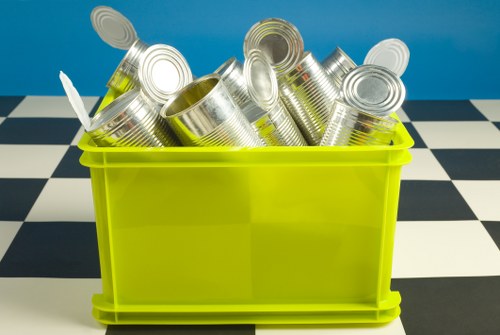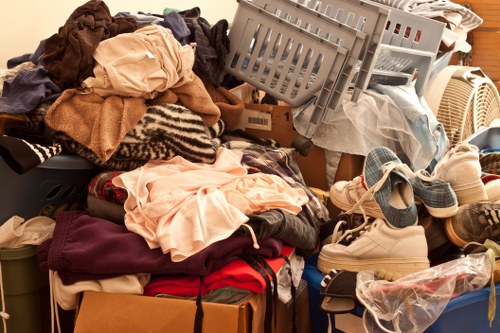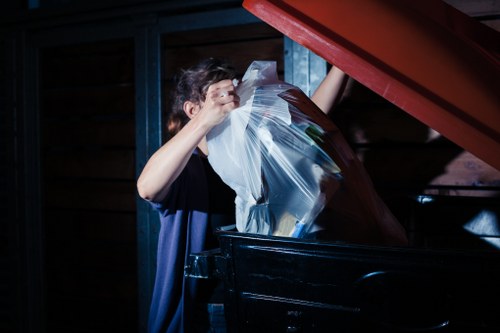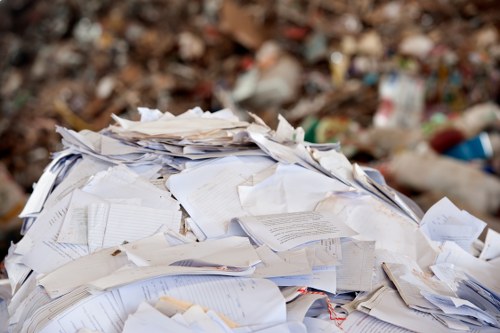Comprehensive Guide to Large Item Collection in Council Rubbish Collection
Understanding Large Item Collection Services

When it comes to managing household waste, large item collection in council rubbish collection services play a crucial role in keeping our communities clean and organized. These services are designed to handle bulky items that regular rubbish collection cannot accommodate, ensuring that even the largest of waste materials are disposed of responsibly.
Large items can include furniture, appliances, mattresses, and other bulky household goods. Without proper disposal, these items can clutter neighborhoods and pose environmental hazards. Council rubbish collection services ensure that such items are collected efficiently, recycled when possible, and disposed of in an eco-friendly manner.
Understanding the scope and process of large item collection can help residents make informed decisions about waste disposal, contributing to a cleaner and more sustainable environment.
The Importance of Proper Large Item Disposal

Proper disposal of large items is essential for several reasons. Firstly, it helps in maintaining the aesthetic appeal of neighborhoods by preventing unsightly piles of waste. Secondly, it reduces the risk of environmental pollution by ensuring that hazardous materials are handled correctly.
Moreover, responsible large item collection supports recycling initiatives. Many large items contain components that can be recycled or repurposed, reducing the overall waste sent to landfills. By utilizing council rubbish collection services, residents contribute to a circular economy, where materials are reused and recycled, minimizing the environmental impact.
Failing to dispose of large items properly can lead to fines and penalties, as many councils have strict regulations regarding waste management. Understanding and adhering to these guidelines helps in avoiding legal issues while promoting community welfare.
Types of Items Eligible for Collection

Not all large items are eligible for council rubbish collection. Typically, the following items can be collected:
- Furniture such as sofas, chairs, and tables
- Home appliances including refrigerators, washing machines, and ovens
- Mattresses and bedding
- Electronic devices like TVs and computers
- Bicycles and sporting equipment
- Garden waste including large branches and soil
It's important to check with the local council for specific guidelines, as some items may require special handling or disposal methods. For instance, electronic waste often needs to be recycled through designated facilities to prevent the release of harmful substances into the environment.
Additionally, some councils may offer bulk waste days or special collections for large item disposal, making the process more convenient for residents.
Scheduling and Booking Your Collection

To ensure a smooth large item collection process, scheduling and booking your service in advance is recommended. Most councils provide online portals or phone services where residents can request a collection date.
- Check Eligibility: Verify that the item you wish to dispose of is accepted by your council's large item collection service.
- Book a Date: Use the council's website or contact their customer service to schedule a collection.
- Prepare the Item: Ensure the item is ready for collection by placing it in a designated area, such as your front yard or driveway.
- Mark the Collection: Clearly label the item with any required identification or markers as per council instructions.
Booking in advance helps in managing the collection schedule effectively and reduces the chances of delays or missed appointments.
Preparing Your Large Items for Collection

Proper preparation of large items for collection is essential to facilitate an efficient disposal process. Here are some steps to ensure your items are ready:
- Clean the items: Remove any food residues, liquids, or waste from the items to prevent unpleasant odors and pest attraction.
- Disassemble if necessary: Break down larger items into smaller, manageable pieces to make handling easier for the collection team.
- Secure loose parts: Fasten any detachable components to prevent them from falling off during transportation.
- Place on the correct side: Ensure items are placed on the side of the property designated by the council for waste collection.
Additionally, removing any personal belongings from the items before collection is crucial to avoid loss or theft.
Recycling and Environmental Considerations
Environmental sustainability is a key aspect of large item collection in council rubbish collection. Many councils prioritize recycling and aim to minimize the environmental impact of waste disposal.
Recyclable materials such as metal, plastic, and glass are separated and processed accordingly. For example, old appliances may be taken apart to recover valuable metals, while wooden furniture might be chipped for mulch or composting.
By participating in council rubbish collection, residents support these green initiatives, ensuring that valuable resources are reclaimed and reused instead of contributing to landfill mass.
Costs and Fees Associated with Collection
While some councils offer free large item collection services, others may charge a fee depending on the type and number of items. It's important to review your local council's pricing structure before scheduling a collection.
- Free Collection: Certain councils provide complimentary services within specific limits, such as a maximum number of items per household.
- Fee-Based Collection: Additional items or bulk collections may incur charges. Fees can vary based on item type, size, and the number of collections per year.
- Penalty Fees: Improper disposal or exceeding allowed limits can result in fines.
Understanding the cost implications helps in budgeting for waste disposal and avoiding unexpected expenses.
Regulations and Compliance
Adhering to local regulations is essential when participating in large item collection in council rubbish collection. Councils have specific rules to ensure the safe and lawful disposal of waste.
Key regulations may include:
- Prohibiting the disposal of hazardous materials like chemicals, paint, and batteries.
- Setting limits on the number of large items per collection.
- Mandating proper preparation and placement of items for collection.
- Enforcing penalties for non-compliance.
Familiarizing yourself with these rules helps in maintaining compliance and contributes to the effective operation of waste management services.
Benefits to the Community and Environment
Engaging in large item collection in council rubbish collection offers numerous benefits:
- Community Cleanliness: Regular collection services prevent waste buildup, enhancing the visual appeal and hygiene of neighborhoods.
- Environmental Protection: Proper disposal and recycling reduce landfill usage and environmental pollution.
- Resource Conservation:
- Recycling preserves natural resources by reusing materials.
- Energy savings result from manufacturing with recycled materials.
- Reduction in greenhouse gas emissions through decreased waste processing.
These benefits collectively foster a healthier, more sustainable community for current and future generations.
Tips for Efficient Large Item Disposal
To maximize the effectiveness of large item collection services, consider the following tips:
- Plan Ahead: Schedule collections well in advance to ensure timely disposal.
- Sort Items: Separate recyclable materials from non-recyclables to streamline the processing phase.
- Utilize Bulk Waste Days: Participate in scheduled bulk waste collection days for large-scale disposals.
- Maintain Regular Decluttering: Regularly assess and remove unwanted items to prevent accumulation.
Implementing these practices enhances the efficiency of waste management and supports the council's sustainability goals.
Common FAQs About Large Item Collection
- How many large items can I dispose of per collection?
Most councils allow a limited number of large items per collection. Check with your local council for specific limits. - Are there items that cannot be collected?
Yes, hazardous materials, tires, and certain electronics may be excluded. Refer to council guidelines for a comprehensive list. - Do I need to prepare the items before collection?
Yes, items should be clean, disassembled if necessary, and placed in the designated collection area. - Is there a fee for large item collection?
Fees vary by council. Some offer free services within limits, while others charge based on the number and type of items.
The Process of Large Item Collection
- Request a Collection: Initiate the process by booking a collection through the council's portal or customer service.
- Prepare the Item: Ensure the large item is ready for pickup.
- Collection Day: The council's waste management team will collect and process the item.
- Recycling and Disposal: Items are sorted for recycling or safely disposed of according to environmental standards.
This streamlined process ensures that large items are handled efficiently, minimizing inconvenience to residents and maximizing environmental benefits.
Innovations in Large Item Collection
Advancements in waste management technology have enhanced large item collection in council rubbish collection. Innovations include:
- Automated scheduling systems that optimize collection routes and times.
- Advanced recycling techniques that efficiently sort and process various materials.
- Environmental monitoring tools to track and reduce the carbon footprint of waste collection.
- Community engagement platforms that educate and involve residents in sustainable practices.
These innovations contribute to more effective and sustainable waste management, benefiting both the environment and the community.
How to Get Started with Large Item Collection
Embarking on large item collection is straightforward. Follow these steps to begin:
- Visit Your Council's Website: Access information about large item collection services, guidelines, and booking procedures.
- Identify Eligible Items: Determine which items qualify for collection based on council regulations.
- Schedule a Collection: Use the online booking system or contact customer service to arrange a pickup date.
- Prepare the Items: Clean, disassemble, and position the items as per council instructions.
- Await Collection: Ensure availability on collection day and make any necessary arrangements.
Starting the process early and following guidelines helps in seamless disposal and contributes to community cleanliness.
Community Involvement and Feedback
Active community involvement is essential for the success of large item collection in council rubbish collection services. Residents can provide feedback to improve services, participate in recycling programs, and engage in local clean-up initiatives.
By voicing their opinions and suggestions, community members help councils tailor waste management services to better meet their needs, fostering a collaborative approach to environmental stewardship.
Future of Large Item Collection Services
The future of large item collection is geared towards greater sustainability and efficiency. Emerging trends include:
- Integration of smart technologies for real-time tracking and management.
- Enhanced recycling processes that maximize material recovery.
- Increased emphasis on circular economy principles to reduce waste.
- Community education programs to promote responsible disposal habits.
These developments aim to create a more effective and environmentally friendly waste management system, benefiting both the community and the planet.
Take Action Today
Don't let large items clutter your space and harm the environment. Book your large item collection with your local council today and contribute to a cleaner, greener community. Whether it's old furniture, appliances, or mattresses, proper disposal is just a click or a call away. Contact us today to schedule your service and make a positive impact on your surroundings.